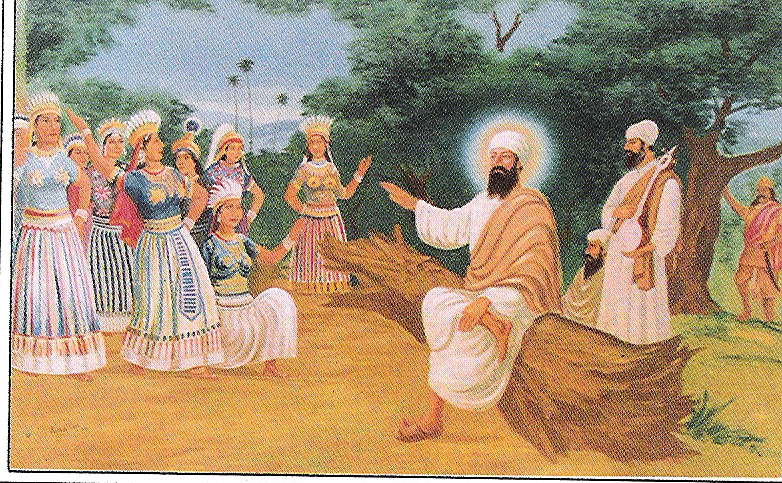RAJA SHIVNABH
Raja Shivnabh was, according to the Janam Sakhi tradition, a Ceylonese king who became a devotee of Guru Nanak. It was a merchant of Lahore Bhai Mansukh who, during a visit to Ceylon then known as 'Sinhaldvip' or 'Singhal dip', had impressed the king with his conduct as well as with his accounts of a holy man he described as his perfect Guru, Guru Nanak.
Shivnabh became interested in Guru Nanak and was anxious to meet him. But Mansukh advised him to meditate on the Guru and wait for him in Ceylon itself. Since then the Raja had awaited the Guru`s coming. Guru Nanak travelled to the far off 'Singhal dip' — the island of Singhs (Lions) accompanied, according to the Puratan Janam Sakhi by two disciples, Saido and Siho.
Raja Shivnabh along with his wife Chandrakala, and their 12 year old son, entered the path of discipleship. So did some of the populace. At the Guru`s suggestion, Shivnabh established a dharamsala where the faithful assembled by night to pray and recite hymns in praise of God. While in Ceylon, relates the Puratan Janam Sakhi, Guru Nanak was inspired to utter Pran Sangli, a metrical composition of twentyone stanzas describing the state of true religious discernment. A written script was made by Saido and left with Raja Shivnabh.
When Guru Arjan (1563-1606) began to collect the sayings of his predecessors for inclusion in the Scripture, a Sikh by the name of Bhai Paira was sent to Ceylon in search of this composition. The copy that he brought back was not regarded as genuine by the Guru and was thus excluded from the sacred volume he was compiling. It was however included in Bhai Banno`s copy of the Scripture as Haqiqat Rah Maqam Shivnabh Raje KI, which is considered by the Sikhs as an apocryphal composition.
Concerning Ceylon's Names
It was thought that Ceylon once abounded in lions or possibly that the many statues of lions all over Ceylon, which were used to represent Buddha, caused the early Arab and Portuguese traders to label Ceylon 'Lion Island'; the Arab version - Sarandvip gives us the English word Serendipity.
Similarily all over China, Statues of Lions known inncorectly as Fu Dogs in the west, are also used to represent Buddha, as is the famous Lion column capital of the Indian Emperor Ashok whose wheel of Dharma, on the same sculpture, adorns the Indian flag.
Also see: Raja Shivnabh And Guru Nanak Dev
References
1. Vir SINGH, Bhai, ed., Puratan Janam Sakhi. AMRITSAR, 1971
2. Santokh Singh, Bhai, Sri Gur Pratap Suraj GRANTH. Amritsar, 1927-35
3. Kirpal Singh,Janam Sakhi Parampara. PATIALA, 1969
4. Macauliffe, M.A., The Sikh Religion, Oxford, 1909
5. Harbans Singh, Guru Nanak and Origins of the Sikh Faith. Bombay, 1969


